Purchasing your first acoustic guitar is a momentous occasion, a memory you’ll treasure throughout your musical journey. Like many, I vividly remember the thrill of acquiring my very first flat-top guitar as a beginner. To ensure that initial excitement translates into lasting passion, it’s crucial to invest time in researching and identifying the best Starter Acoustic Guitar that aligns perfectly with your specific needs right from the outset. Fortunately, you’ve landed in the right place for guidance. I’m Daryl, and I’m dedicated to helping you navigate the captivating world of acoustic guitars designed for beginners. Drawing upon nearly a decade of experience as a music retail manager, I’ve had the privilege of assisting countless aspiring musicians in selecting their very first instrument. Now, I share my expertise and insights as a contributing writer for Guitar World.
In my experience, an exceptional starter acoustic guitar should be inviting and comfortable for new players to learn on, possess a pleasing sound that keeps them motivated, and remain affordable and accessible to the majority of budding guitarists. Every instrument featured in this guide, in my opinion, successfully embodies these qualities.
I’ve invested significant effort in compiling this comprehensive guide to equip you with all the necessary information to make a well-informed decision. Alongside detailed reviews outlining the key features of each guitar, you’ll also find a video demonstration for every top recommendation. In these videos, I play each guitar across a range of dynamics, enabling you to directly compare their unique sonic characteristics. Furthermore, I’ve included sizing photographs so you can visually assess the dimensions of each model – especially beneficial if you’re buying a guitar for a child or if you are a player with a smaller frame. For reference, I stand at 5’11”.
Currently, my top pick overall for a starter acoustic guitar is the Fender CD-60S. In my expert opinion, this dreadnought model achieves an outstanding balance of playability and affordability. Frankly, if you’re simply seeking a fantastic guitar that won’t break the bank, this flat-top is an ideal choice. For younger players, I recommend the Gretsch Jim Dandy. This guitar is noticeably smaller than the Fender, making it a more comfortable fit for children. Its attractive appearance is an added bonus. For adult beginners wanting an instrument with a more mature feel and tone, I highly recommend Yamaha’s classic FG800.
If you encounter any unfamiliar terms in this guide, I’ve included a comprehensive glossary that clarifies all the essential terminology. You’ll also find a helpful FAQ section further down the page.
Quick List of Starter Acoustic Guitars
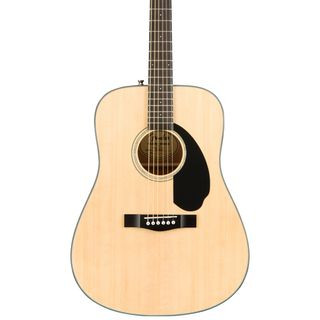 Studio shot of the best starter acoustic guitars for beginners
Studio shot of the best starter acoustic guitars for beginners
Best Starter Acoustic Guitar Overall: Fender CD-60S
- Fender CD-60S
With the Fender CD-60S, you get a leading brand delivering an exceptional acoustic guitar at an entry-level price point. Our testing revealed that this dreadnought’s all-mahogany construction produces a rich, well-rounded sound with excellent playability.
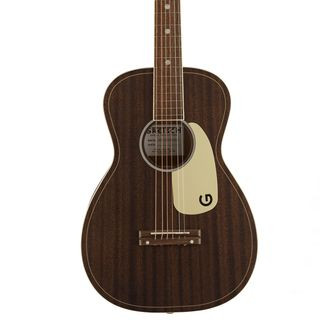 Studio shot of the Gretsch G9500 Jim Dandy, a top starter acoustic guitar for kids
Studio shot of the Gretsch G9500 Jim Dandy, a top starter acoustic guitar for kids
Best Starter Acoustic Guitar for Kids: Gretsch G9500 Jim Dandy
- Gretsch G9500 Jim Dandy
We are immediately drawn to the vintage aesthetic of the Gretsch G9500 Jim Dandy. Its smaller size and striking finish exude old-school charm. However, to earn a place in this guide to the best starter acoustic guitars, it needs to be more than just visually appealing – thankfully, the G9500 exceeds expectations.
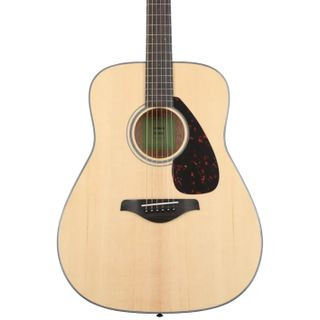 Studio shot of the Yamaha FG800, a top starter acoustic guitar for adults
Studio shot of the Yamaha FG800, a top starter acoustic guitar for adults
Best Starter Acoustic Guitar for Adults: Yamaha FG800
- Yamaha FG800
The Yamaha FG800, one of the most affordable guitars in our guide, is a seasoned veteran in the realm of starter acoustic guitars. The impressive sound quality of this instrument rivals that of much pricier guitars, and it’s known for its reliable tuning stability.
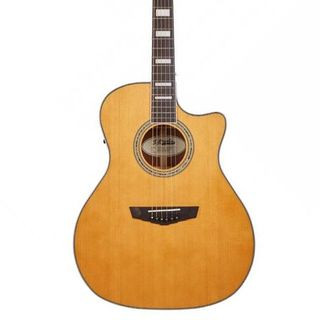 Studio shot of the D'Angelico Premier Gramercy, a top starter acoustic guitar with a cutaway
Studio shot of the D'Angelico Premier Gramercy, a top starter acoustic guitar with a cutaway
Best Starter Acoustic Guitar with a Cutaway: D’Angelico Premier Gramercy
- D’Angelico Premier Gramercy
The D’Angelico Premier Gramercy stands out from typical starter acoustic guitars with its quality construction, easy playability, and striking visual appeal.
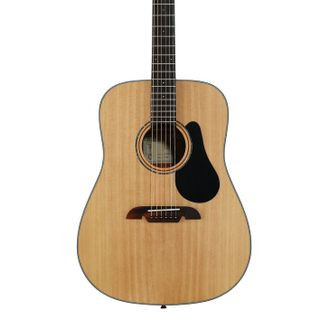 Studio shot of the Alvarez AD30, a top starter acoustic guitar under 0
Studio shot of the Alvarez AD30, a top starter acoustic guitar under 0
Best Starter Acoustic Guitar Under $500: Alvarez AD30
- Alvarez AD30
Priced around $270, the Alvarez AD30 is another dreadnought model that delivers exceptional value far exceeding its modest price tag. Its sitka spruce body produces a significant volume that is both warm and bright in tone.
 Studio shot of the Taylor GS Mini-e, a top electro-acoustic starter guitar
Studio shot of the Taylor GS Mini-e, a top electro-acoustic starter guitar
Best Electro-Acoustic Starter Guitar: Taylor GS Mini-e
- Taylor GS Mini-e
The Taylor GS Mini-e is a versatile instrument that works well as both a travel-sized guitar and a starter acoustic guitar for home practice, especially for younger or smaller players. Its factory-set low action makes it easy to play from the start.
Best Overall Starter Acoustic Guitar
1. Fender CD-60S
The best starter acoustic guitar for beginners who want a well-known brand name.
Our expert review:
Specifications
Type: Dreadnought
Top: Solid spruce
Back and sides: Laminated mahogany
Neck: Mahogany
Fingerboard: Rosewood
Frets: 20
Electronics: N/A
Left-handed: Yes
Reasons to Buy
+Balanced sound
+Stays in tune
+Entry-level price
Reasons to Avoid
-Unassuming aesthetics may not appeal to everyone
At a Glance
✅ Buy If you want a big-name brand on a budget: Fender, the most recognized name in guitars, offers the CD-60S as a perfect entry-level instrument from this iconic brand.
❌ Avoid if you are small or prefer smaller guitars: The dreadnought body of the CD-60S delivers a powerful sound, but its size might be overwhelming for some players.
Ratings
Value: ★★★★★
Playability: ★★★★☆
Sound: ★★★★☆
Overall: ★★★★★
With this Fender, you benefit from a leading brand producing an excellent acoustic guitar at an accessible entry-level price. In my evaluations, I observed that this dreadnought’s solid top construction produces a full, rounded tone, translating to strong volume and confident mid-range presence supporting a bright treble.
The tuners are reliable and responsive, offering exceptional quality for guitars in the sub-$200 price range. Historically, Fender’s starter acoustic guitars were known for having a somewhat high action. However, the CD-60S features a lower action, enhancing playability while minimizing fret buzz.
Being a dreadnought guitar, it’s better suited for adults or older children due to its size and scale. For younger players, we suggest considering the next option in this guide, the Gretsch Jim Dandy, as its design is more appropriate for children, providing a more comfortable playing experience.
In our review, we noted, “Crucially for a starter acoustic guitar, Fender has perfected the neck profile. The CD-60S is a joy to play, complemented by an impressive tone that makes chords sound full and expansive, with a detailed midrange and vibrant high-end that adds a touch of magic.” High praise indeed for such an affordable acoustic guitar.
Fender CD-60S starter acoustic guitar demo on YouTube
Watch the Fender CD-60S Demo Video
Expert Verdict: Fender CD-60S Starter Acoustic Guitar
Expert Verdict: Fender CD-60S – Jonathan Horsley
“I found the CD-60S to be a highly playable dreadnought with a broad, balanced tone that belies its modest price. Ideal for beginners – enjoyable for players of all levels.”
Read more: Fender CD-60S review
Best Starter Acoustic Guitar for Kids
2. Gretsch G9500 Jim Dandy
The best starter acoustic guitar for children and players with smaller hands.
Our expert review:
Specifications
Type: Parlour
Top: Basswood
Back and sides: Basswood
Neck: Nato
Fingerboard: Black walnut
Frets: 18
Electronics: N/A
Left-handed: No
Reasons to Buy
+Excellent sound and projection for its size
+Reliable tuning stability
+Short 24″ scale length ideal for kids and beginners
Reasons to Avoid
-Fretboard might feel cramped for players with larger hands
At a Glance
✅ Buy if you want a traditional-sounding guitar: The Jim Dandy offers a vintage charm with a sound to match. It’s warm and full of character.
❌ Avoid if you need built-in electronics: If you envision performing on stage eventually, consider a model with a pickup system.
Ratings
Value: ★★★★☆
Playability: ★★★★☆
Sound: ★★★½
Overall: ★★★★½
I must begin by expressing my admiration for the visual appeal of the Gretsch G9500 Jim Dandy. Its compact size and stunning finish exude vintage charm. However, to earn its place in this guide to the best starter acoustic guitars, it must offer more than just good looks – thankfully, the G9500 truly delivers.
In our review, we highlighted our positive impression of the guitar’s low action and consistent playability across the neck. Tonally, it aligns with expectations. Naturally, the smaller body size means it won’t have the bass response and resonance of a standard dreadnought. Instead, the tone is bright without being harsh when strummed, and fingerpicked notes have a distinct ‘pluck’ with a strong attack and slightly shorter sustain.
There are few starter acoustic guitars that are as enjoyable to play, and even fewer from reputable brands at this price point – making it an easy recommendation from Guitar World. Looking for more options for younger players? Explore my comprehensive guide to the best guitars for kids.
However, it’s worth noting that this guitar is quite small and might be too compact for adults or older children. Keep this in mind when making your purchase. For adults, we recommend either the Fender CD-60S or the Yamaha FG800.
Gretsch Jim Dandy Concert starter acoustic guitar demo on YouTube
Watch the Gretsch Jim Dandy Demo Video
Expert Verdict: Gretsch G9500 Jim Dandy Starter Acoustic Guitar
Expert Verdict: Gretsch G9500 Jim Dandy – Stuart Williams
“With its striking looks, short scale length, and affordable price, I believe this is an ideal guitar for both younger players and adults.”
Read more: Gretsch G9500 Jim Dandy review
Best Starter Acoustic Guitar for Adults
3. Yamaha FG800
A dependable best-selling starter acoustic guitar that’s perfect for adults.
Our expert review:
Specifications
Type: Traditional Western
Top: Solid spruce
Back and sides: Nato/Okume
Neck: Nato
Fingerboard: Rosewood
Frets: 20
Electronics: n/a
Left-handed: Yes
Reasons to Buy
+Exceptional sound for the price
+Solid build quality
+Affordable
Reasons to Avoid
-Lacks electronics
At a Glance
✅ Buy if you are seeking superb build quality: Yamaha is known for offering the best build quality in this price range. Their guitars are impeccably finished and well-crafted.
❌ Avoid if you need built-in electronics: This model does not include a preamp or pickup.
Ratings
Value: ★★★★★
Playability: ★★★★☆
Sound: ★★★★★
Overall: ★★★★★
The Yamaha FG800, one of the more budget-friendly guitars in our guide, is a long-standing favorite in the starter acoustic guitar category – but don’t underestimate it because of its low price.
During my time in music retail, I must have sold hundreds of these guitars over the years. While filming the demo videos for this guide, I was reminded of just how impressive this model sounds (a sentiment echoed by our cameraman and sound engineer). The sound quality of this instrument rivals that of more expensive guitars, and it reliably holds its tuning.
A solid spruce top, typically found on higher-priced guitars, contributes to its impressive tone. We believe the sound truly sets this guitar apart from others in the sub-$200 range. While it doesn’t include amplification, at this price, it’s hardly a drawback.
While the neck has a comfortable, rounded profile, the body is quite large – making it unsuitable for young children. The Yamaha FG800 is our top recommendation for adult beginners seeking a starter acoustic guitar, as its simple finish and larger body size make it ideal for older players.
Yamaha FG800 starter acoustic guitar demo on YouTube
Watch the Yamaha FG800 Demo Video
Expert Verdict: Yamaha FG800 Starter Acoustic Guitar
Expert Verdict: Yamaha FG800 – Daryl Robertson
“Without a doubt, the Yamaha FG800 is one of the greatest starter acoustic guitars of all time. Its solid top helps produce a rich, full-bodied tone typically found in more expensive instruments. Additionally, the smooth neck is comfortable, highly playable, and perfect for players at the beginning of their musical journey.”
Read more: Yamaha FG800 review
Best Starter Acoustic Guitar with a Cutaway
4. D’Angelico Premier Gramercy
If you need a cutaway, this starter acoustic guitar is for you.
Our expert review:
Specifications
Type: Grand Auditorium Cutaway
Top: Solid Spruce
Back and sides: Laminated Sapele
Neck: Mahogany
Fingerboard: Rosewood
Frets: 20
Electronics: Yes
Left-handed: Yes
Reasons to Buy
+Well-balanced sound
+Relatively lightweight
+Cutaway for easier access to higher frets
Reasons to Avoid
-Tone might be too bright for some preferences
At a Glance
✅ Buy if you want superior upper-fret access: The cutaway design of this guitar makes it ideal for players who want to play lead parts higher up the fingerboard.
❌ Avoid if you don’t prefer bright-sounding guitars: This guitar has a very crisp tone that some may find a bit harsh. If you prefer a warmer tone, consider a different model.
Ratings
Value: ★★★★☆
Playability: ★★★★☆
Sound: ★★★★☆
Overall: ★★★★☆
The D’Angelico Premier Gramercy is not your typical starter acoustic guitar, standing out with its quality construction, easy playability, and striking visual flair.
Featuring a grand auditorium body shape, this single-cutaway guitar is well-suited for players with a slightly smaller build. The common combination of a solid spruce top and sapele back and sides delivers a bright and articulate attack that, to my ears, sounds equally good whether strummed with a pick or played fingerstyle.
When selecting a guitar, I believe it’s important to look beyond the beginner stage. If your budget allows, you should definitely consider purchasing a guitar that is more future-proof. Thankfully, this D’Angelico fits that description. Equipped with a discreet Fishman pickup system, this stunning starter acoustic guitar is ready for stage performance straight out of the box.
D’Angelico Premier Gramercy starter acoustic guitar demo on YouTube
Watch the D’Angelico Premier Gramercy Demo Video
Expert Verdict: D’Angelico Premier Gramercy Starter Acoustic Guitar
Expert Verdict: D’Angelico Premier Gramercy – Chris Corfield
“In my opinion, the D’Angelico Premier Gramercy is undeniably a fine guitar for the money. It’s well-made, sounds good, and has an appealing look. While some players might find the tone a bit bright, the Premier Gramercy offers exceptional value for players at all skill levels.”
Read more: D’Angelico Premier Gramercy review
Best Starter Acoustic Guitar Under $500
5. Alvarez AD30
Conventional design with fantastic tone – a superb starter acoustic guitar for under $500.
Our expert review:
Specifications
Type: Dreadnought
Top: Solid Sitka spruce
Back and sides: Mahogany laminate
Neck: Mahogany 50/50 semi gloss
Fingerboard: Richlite
Frets: 20
Electronics: N/A
Left-handed: Yes
Reasons to Buy
+Good volume and power
+Versatile for various musical styles
+Excellent value
Reasons to Avoid
-No pickup included
At a Glance
✅ Buy if you want volume and power: This guitar is bright, loud, and powerful. We love the sound of this guitar, and we believe you will too!
❌ Avoid if you don’t prefer dreadnought guitars: Dreadnought guitars aren’t for everyone due to their larger body size. If you prefer a smaller body, consider a concert or folk-sized guitar.
Ratings
Value: ★★★★★
Playability: ★★★★☆
Sound: ★★★★☆
Overall: ★★★★☆
The Alvarez AD30, priced around $270, is another dreadnought that performs well above its affordable price point. In my testing, I found that its sitka spruce-topped mahogany body produces significant volume, with a tone that is both warm and bright.
The playing dynamics range from subtle to aggressive, and this is where the AD30 delivers surprising power. The X-bracing design is intended to enhance resonance, which is certainly noticeable.
The guitar’s construction is robust, and it maintains reliable tuning stability. The 50/50 gloss to matte finish on the neck balances durability with ease of play. Conventional yet dependable, the AD30 is a reliable all-around starter acoustic guitar.
The “under $500” price range is quite competitive, with almost every brand offering a guitar in this bracket. However, my top pick is the Alvarez AD30. This guitar is exceptionally well-constructed, and its tone is vibrant and engaging.
Alvarez AD30 starter acoustic guitar demo on YouTube
Watch the Alvarez AD30 Demo Video
Expert Verdict: Alvarez AD30 Starter Acoustic Guitar
Expert Verdict: Alvarez AD30 – Richard Blenkinsop
“Boasting impressive specifications, I found that the Alvarez AD30 delivers the classic dreadnought sound and response that we all know and love at a fantastic price. For me, this is more than just a superb first guitar; it’s also a fun and reliable workhorse.”
Read more: Alvarez AD30 review
Best Electro-Acoustic Starter Guitar
6. Taylor GS Mini-e
A fantastic starter guitar that sounds even better when amplified.
Our expert review:
Specifications
Type: Mini
Top: Spruce
Back and sides: Rosewood
Neck: Layered sapele
Fingerboard: Ebony
Frets: 20
Electronics: Yes
Left-handed: Yes
Reasons to Buy
+High-quality tone
+Extremely versatile sounds
+Exceptional build quality
Reasons to Avoid
-Lesser volume compared to full-size guitars
At a Glance
✅ Buy if you are seeking a comfortable small-body guitar: The Taylor GS Mini is enjoyable to play and incredibly comfortable for players of all ages.
❌ Avoid if you require a loud guitar: Due to its smaller body, this is not the loudest guitar on this list.
Ratings
Value: ★★★★☆
Playability: ★★★★★
Sound: ★★★★☆
Overall: ★★★★☆
The Taylor GS Mini-e serves dual purposes as a travel-sized guitar and an excellent starter acoustic guitar for home practice, especially for younger or smaller guitarists. The factory-set action is low, making it easy to play right from the start.
I found the sound to be warm and clear, leaning towards the mid-range frequencies. While the trebles are bright, the bass response is surprisingly present despite its smaller size. The sound also features ample sustain, with notes lasting longer than expected from a ‘mini’ guitar. The onboard electronics deliver a stunning amplified tone that rivals more premium models.
Its broad tonal capabilities make it well-suited to a variety of musical styles. This versatility makes it one of the best starter acoustic guitars if you’re looking for tonal flexibility and an entry-level instrument that can last well beyond your initial learning years.
Notably, it also tops our list for the best guitar for small hands and is our preferred starter acoustic guitar for those seeking an electro-acoustic model – the versatile GS Mini truly does it all!
Taylor GS Mini starter acoustic guitar demo on YouTube
Watch the Taylor GS Mini Demo Video
Expert Verdict: Taylor GS Mini Starter Acoustic Guitar
Expert Verdict: Taylor GS Mini – Daryl Robertson
“They say good things come in small packages, and Taylor certainly proves that with the GS Mini. This scaled-down guitar is not only incredibly fun to play, but I believe its sound rivals some of its larger-bodied competitors.”
Read more: Taylor GS Mini Mahogany review
Starter Acoustic Guitar Spec Comparison
See how our top starter acoustic guitar choices compare side-by-side.
Swipe to scroll horizontally
| Model | Retail price | Style | Solid Top | Electronics | Suited for |
|---|---|---|---|---|---|
| Fender CD-60S | $199/£149 | Dreadnought | Yes | No | Adults/older kids |
| Gretsch Jim Dandy | $189/£189 | Parlor | No | No | Kids/smaller players |
| Yamaha FG800 | $229/£248 | Dreadnought | Yes | No | Adults/older kids |
| D’Angelico Premier Gramercy | $249/£199 | Grand Auditorium | Yes | Yes | Adults/older kids |
| Alvarez AD30 | $329/£249 | Dreadnought | Yes | No | Adults/older kids |
| Taylor GS Mini-e | $699/£699 | GS Mini | Yes | Yes | Kids/smaller players |
Other Starter Acoustic Guitars to Consider
The models above represent our top selections for the best starter acoustic guitars, but to compile this list, we evaluated many more instruments. Below are a few additional starter acoustic guitars that have received positive reviews recently but didn’t quite make our top six.
Epiphone Hummingbird Studio ★★★★☆
Type: Dreadnought | Top: Solid Spruce | Back & Sides: Mahogany
Based on its iconic Gibson counterpart, the ‘real’ Hummingbird would cost you closer to $3,000, making this Epiphone a bargain and easily one of the best acoustic guitars under $500. We found its sound well-balanced, suitable for various styles, though the factory action could be slightly lower for beginner comfort. For amplified performance, Epiphone’s built-in ePerformer preamp offers versatile tonal options. Additionally, we found the Grover tuners maintained reliable tuning stability.
Read more: Epiphone Hummingbird Studio review
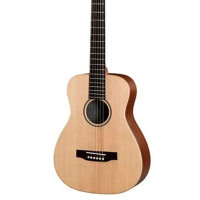 Martin LX1E Little Martin starter acoustic guitar
Martin LX1E Little Martin starter acoustic guitar
Martin LX1E Little Martin ★★★★☆
Type: Travel guitar | Top: Spruce | Back & Sides: HPL
Don’t let the size deceive you. In our testing, this guitar provided surprising volume from its Sitka spruce top and mahogany laminate sides, along with a bright tone. The high-pressure laminate construction also helps withstand temperature and humidity changes, ideal for travel. Fishman Sonitone electronics offer a range of volume and tone control, including a phase control to enhance bass response at lower volumes.
Read more: Martin LX1E Little Martin review
Seagull S6 Original ★★★★☆
Type: Dreadnought | Top: Solid Cedar | Back & Sides: Wild Cherry
Canadian-made Seagull guitars are known for their high build quality, and the S6 is no exception. It’s a mature instrument in that it’s not flashy, but it has everything you need to progress beyond your beginner days. Its refined construction is matched by a bright tone, particularly well-suited for gentle fingerpicking, where the Seagull S6 delivers beautiful warmth with a light touch and lower volume. As expected from this level of craftsmanship, this starter acoustic guitar stays in tune and is enjoyable to play.
Glossary of Key Terms for Starter Acoustic Guitars
I understand that the terminology used when discussing starter acoustic guitars can be confusing. Before we delve deeper into the advice, here are the definitions of common terms you’ll encounter in this guide and beyond.
Body style: Acoustic guitars come in various shapes and sizes, from parlor and grand auditorium to dreadnought and jumbo. Typically, the right size for you at this stage in your playing journey comes down to physical comfort. We discuss guitar sizes in more detail below.
Top: The top of the guitar refers to the wood on the instrument’s soundboard. This can be solid wood or a laminate (layers of wood). The type of wood used for the top significantly influences the guitar’s tone.
Back & sides: Similar to the top, the back and sides of a starter acoustic guitar can be made from various woods. At this price point, laminate construction is most common, as all-solid wood guitars are generally much more expensive.
Fingerboard: The fingerboard is the playing surface on the guitar neck. It can be made from materials ranging from rosewood to walnut, Richlite, and pau ferro. Each material imparts unique characteristics, and personal preference largely dictates which you’ll prefer.
Scale length: Simply put, scale length is the distance between the nut at the headstock and the saddle on the bridge – measuring the total playable string length.
Electronics: In the context of acoustic guitars, “electronics” refers to pickup systems, preamps, or even onboard tuners. While not essential at the very beginning, if you aspire to play live, you’ll want to consider a model with electronics.
How to Choose the Best Starter Acoustic Guitar for You
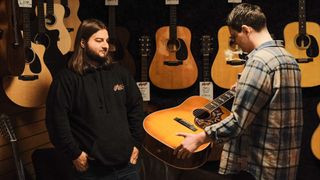 Shopping for a starter acoustic guitar
Shopping for a starter acoustic guitar
If you’re reading this guide, you’re likely looking for one of the best starter acoustic guitars, either for yourself or someone you know. In this section, I’ve compiled everything you need to know to make the right choice, from essential features to consider to specific advice for parents buying a guitar for their child. This advice is rooted in my decade of experience buying, selling, and reviewing guitars.
Before diving into buying advice, it’s worth noting that most models in this guide are available in left-handed versions, so left-handed players can also find suitable options among our recommendations.
Here’s a quick checklist of factors to consider before buying your starter acoustic guitar:
- Consider guitar size: Do you need a mini acoustic, small-bodied acoustic, dreadnought, or jumbo? Unsure what these terms mean? I explain different guitar sizes further down this page. If you’re unsure about the right size, remember that you should be able to comfortably drape your right arm over the body, and when seated with the guitar on your lap, reach the end of the headstock without excessive stretching.
- Are you buying from a reputable brand? Fender, Epiphone, Yamaha, and Taylor are well-known, trusted brands and excellent starting points.
- Does the guitar have low action? Action refers to the string height above the fretboard – lower action makes a starter acoustic guitar easier and more comfortable to play.
- Do you want to play higher notes? You’ll need a guitar with a cutaway to access the higher frets more easily.
- Do you have a guitar tuner? A tuner is a wise investment to keep your guitar sounding its best. I recommend purchasing one along with your new guitar.
- Do you want to amplify your playing? If you plan to play live through a PA system, you’ll need to add an acoustic guitar pickup or choose an acoustic-electric guitar that already has electronics. My #6 pick is a great option for this.
- Leverage the power of reviews: Once you’ve narrowed your choices, explore reviews. Remember that not all reviews are equally valuable. For a comprehensive understanding, consult both professional editorial reviews and user reviews from forums. This balanced approach will provide the knowledge needed to make an informed decision.
FAQs About Starter Acoustic Guitars
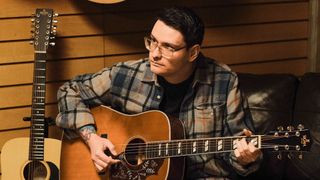 Daryl Robertson, expert reviewer
Daryl Robertson, expert reviewer
Who are starter acoustic guitars designed for?
Starter acoustic guitars are designed for individuals new to guitar playing and looking to begin their musical journey. These guitars cater to a broad range of players, including both children and adults. They are ideal for those just starting to learn guitar and seeking affordable, user-friendly instruments to help them get started.
Whether it’s a child taking their first steps in music or an adult picking up a new hobby, starter acoustic guitars are versatile and suitable for anyone embarking on musical endeavors.
In this guide, I’ve carefully selected models to ensure we cover the full spectrum of players. We include smaller models for kids, budget-friendly options for adults, and even an electro-acoustic model for those aiming to perform.
Are starter acoustic guitars easy to play?
Relatively speaking, beginner guitars should be easy to play. If the guitar makes progress harder than necessary, you’re less likely to practice. This means looking for low action – the height of the acoustic guitar strings above the fretboard.
Besides comfort, a smaller-bodied guitar is also easier to handle, especially for younger or smaller players.
While a dreadnought guitar body typically joins the neck at the 14th fret, offering easier access to higher notes, parlor guitars often join lower, at the 12th fret. If playing higher notes is important for the music you want to play, consider a starter acoustic guitar with a body cutaway below the neck.
Wondering if you should choose electric instead? We’ve compared the pros and cons of each style in this detailed feature: Acoustic vs electric guitar: which is best for beginners?
What are the different acoustic guitar sizes and shapes for starter guitars?
The first consideration is the type of starter acoustic guitar you need, primarily based on size and sound.
Smaller-bodied acoustics are easier to play and more portable. Conversely, larger bodies produce greater volume and a bigger tone. The most common and versatile acoustic guitar design is the dreadnought, which balances sound and playability well.
At the larger end is the jumbo acoustic, producing even greater volume, and at the smaller end is the parlor guitar, with its compact body and softer tone. Even smaller are mini or baby acoustics.
You’ll find a mix of these in this best starter acoustic guitars guide. Established brands in this area include Fender, Epiphone, and Yamaha, with Taylor and Martin notable at the higher end.
How do I tune a starter acoustic guitar?
Tuning is often challenging for beginners, so guitar tuners, which simplify the process and help maintain correct string tension, are essential accessories. If you’re on a tight budget, there are many great affordable clip-on guitar tuners available. These are small, inexpensive, and easy to use.
If you’re really stuck, we’ve created a step-by-step guide showing how to tune a guitar.
How much should I budget for a starter acoustic guitar?
Once you know what you need from your starter acoustic guitar, you can determine your budget. I recommend avoiding sub-$100, unbranded options often found online. You’ll quickly outgrow them and encounter issues like poor tuning stability, high action, and weak sound.
As this guide demonstrates, you can get a well-equipped starter acoustic guitar for around $150. In fact, setting a budget between $150 and $250 will get you a guitar you’ll happily play for years without needing to upgrade.
Increasing your budget slightly will get you better components, improved tone, and possibly even built-in electronics.
Where is the best place to find starter guitar lessons?
Acquiring one of the best starter acoustic guitars is only useful if you learn to play it. Some learn by ear or have someone at home to teach them. If neither applies, I recommend taking lessons if possible.
In-person lessons are great for building a teacher-student relationship and developing skills hands-on. However, if you want to quickly grasp basics, learn at home, and have a limited budget, online lessons are a great, affordable option. You can learn more and find our recommendations in this guide to the best online guitar lessons.
You can currently find savings on some platforms using the codes below.
Where is the best place to buy a starter acoustic guitar?
When buying your first starter acoustic guitar, it’s important to purchase from a reputable site or store. While many music retailers exist, I recommend only the shops and sites that our team trusts and has personally dealt with.
In the US, we highly recommend Guitar Center, Musician’s Friend, Sweetwater, and Fender. These sites consistently offer competitive prices and, more importantly, excellent customer service and generous return policies.
In the UK, start with Thomann, Andertons, PMT, Fender, and Gear4Music. Again, these sites consistently offer excellent prices and stellar customer service.
When is the best time to buy a starter acoustic guitar?
You might think major sales events like Black Friday, Amazon Prime Day, President’s Day, or Memorial Day are the best times to shop. While Black Friday guitar deals are often remarkable, starter acoustic guitars are frequently on sale throughout the year.
Expect significant price drops on big-name brands, heavily discounted bundle deals, and clearance offers even outside of annual sales events.
So, if you’re looking for your first starter acoustic guitar, don’t wait. Check your preferred retailer now to see current offers, or use our price widgets to find the best deals online.
Do I need to test a starter acoustic guitar in a store?
As a former music store employee, I understand that visiting a guitar shop can be intimidating, especially for beginners. However, most shop staff are welcoming and eager to help you find the perfect starter acoustic guitar.
Their goal, and mine, is to ensure you leave with a guitar that suits you and sparks your musical passion. While in-person testing isn’t essential, as many retailers have excellent return policies and customer service, many players prefer to try a guitar before buying.
If you feel that testing a guitar in person would be helpful but are nervous, check out my guide on how to test a beginner acoustic guitar in a guitar store.
Should I rely on user reviews, forums, and influencers for starter acoustic guitar advice?
When searching for a starter acoustic guitar, gather information from various sources. User reviews and forums offer insights into how a guitar performs for beginners. However, professional reviews and unbiased opinions are also valuable.
Professional reviews provide in-depth evaluations of playability, build quality, wood types, and comparisons to other guitars. These reviews explore critical factors you might miss in user reviews alone.
By considering both user experiences and expert evaluations, you can make a well-informed decision when choosing a starter acoustic guitar that meets your needs and preferences.
I’m a parent buying a starter acoustic guitar, what do I need to know?
You can trust Guitar World. Our expert reviewers spend hours testing and comparing guitar products to help you choose the best. Find out more about how we test.
Choosing the best starter acoustic guitar for your child can be daunting. You want to avoid making a wrong choice that hinders their learning or discourages them entirely.
But don’t worry! We have helpful tips for you.
Pay attention to size: Guitars come in various shapes and sizes, so selecting the right size for your child is crucial. As a general guideline, ensure your child can easily reach the end of the neck while seated without overstretching. Typically, we suggest short-scale or 3/4 guitars for children under 12, and full-sized instruments for ages 12 and up.
Price vs. quality: For starter acoustic guitars, you don’t need to spend a lot to get a great instrument. However, aim for the best quality you can afford. Better build quality means better playability and a higher chance of your child sticking with it.
Don’t forget accessories: To maximize your child’s chances of sticking with guitar, ensure they have all necessary accessories: picks, spare strings, a strap, a tuner, and a gig bag for transport.
For more advice, our parent’s guide to buying a guitar for your child offers more top tips.
Why Trust Guitar World for Starter Acoustic Guitar Advice?
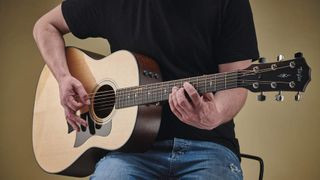 Man playing a Taylor acoustic guitar
Man playing a Taylor acoustic guitar
☑️ A global audience of 3.8 million guitarists monthly
☑️ 1,200+ reviews on GuitarWorld.com
☑️ 30+ years of product testing at Guitar World
Guitar World boasts over 44 years of expertise and is the leading authority on all things guitar-related. The magazine and website offer expertly written gear round-ups and high-quality, authoritative reviews by experienced industry professionals.
Guitar World’s first print issue was published in July 1980, and since then, it has captivated players with engaging lessons, insightful interviews with guitar heroes, and invaluable buying advice for new players.
GuitarWorld.com extends this legacy online, serving as the central resource for the world’s foremost guitar authorities. The site features content from Guitar World and articles from respected publications like Guitarist, Total Guitar, Guitar Techniques, and Bass Player. Reaching 3.8 million players monthly, GuitarWorld.com is a go-to destination for guitar enthusiasts globally.
Below, you’ll find more about the expert author of this guide.
Daryl Robertson
I’m Guitar World’s Senior Deals Writer. I create and maintain over 200 buyer’s guides on the site, find the best deals on guitar products, and test new gear. My reviews have appeared in Total Guitar, Future Music magazine, and MusicRadar.com.
Throughout my career, I’ve interviewed many musical heroes, including Slash and members of The Offspring, Foo Fighters, Sum 41, Thrice, and more. Before joining Guitar World, I worked in music retail at Kenney’s Music in Dundee, Scotland, for a decade. I advised everyone from beginners to seasoned pros on gear, from starter acoustic guitars to high-end modelers.
How We Test Starter Acoustic Guitars
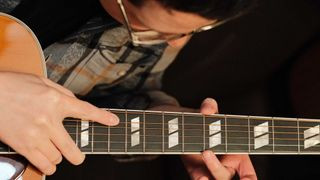 Customer testing an acoustic guitar in a store
Customer testing an acoustic guitar in a store
When it comes to starter acoustic guitars, personal preferences for tone and feel vary. However, certain key criteria must be met before myself and our testing team recommend a starter acoustic guitar.
When reviewing a guitar, we ask:
- How easy is it for a complete beginner to play?
- Does the guitar sound inspiring?
- Is the model well-made and durable?
- Does it offer good value for money?
Here’s a breakdown of our testing process to answer these questions:
Build Quality: We first examine the overall build quality, inspecting every inch of the guitar – body, neck, machine heads, bridge, and saddle – to ensure it feels robust and ready for a musical journey.
Playability: We check fretwork consistency to ensure no sharp or uneven frets cause buzzing. Playability is crucial; the guitar should be comfortable for beginners, with a forgiving neck and unobtrusive body.
Sound: We then assess the sound, using various playing techniques and styles – strumming chords with a pick, fingerpicking, and everything in between. We listen for volume and tonal balance.
Value: Finally, we weigh our assessments of design, performance, and sound against the guitar’s price to determine if it’s a worthwhile investment. Finding the right balance of quality and affordability is key for a starter acoustic guitar.
Learn more about how we make recommendations and how we test starter acoustic guitars.
How We Shoot Our Starter Acoustic Guitar Product Demos
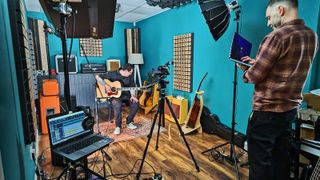 Filming product demos in the Guitar World studio
Filming product demos in the Guitar World studio
Sound is a crucial factor when choosing your first guitar – that’s why I’ve recorded demo videos for every guitar in this guide. This allows you to make an informed decision based on which model sounds best to you.
To keep it simple, I played the same chord progression on each guitar at three dynamic levels: strumming with a plectrum to demonstrate volume range, picking individual notes for clarity, and fingerpicking to show response to subtle nuances.
The team and I recorded videos in our dedicated studio in Bath, UK – the renowned Guitarist Tone Lounge.
To ensure natural tone, we used a crossed microphone technique – X-Y technique – to capture the room’s sound accurately, using a pair of Austrian Audio CC8 condenser mics. This stereo setup typically produces the most true-to-life sound, perfect for hearing the guitar as if you were playing it.
We minimized post-processing, applying light compression for consistent volume levels and EQ to reduce “boomy” room frequencies. Finally, we added a touch of digital reverb for depth.
Latest Updates to this Starter Acoustic Guitar Guide
Recent Updates
18/02/25: We’ve re-examined our choices to ensure we still recommend the very best starter acoustic guitars currently available and most worthy of your investment.
10/10/24: We’ve completely revised this page, adding demo videos for each guitar, sizing guide photos for scale reference, and more in-depth information and clarity to our buying advice section.
06/06/24: In addition to product audits, we’ve expanded our buying advice and testing methodology sections.
